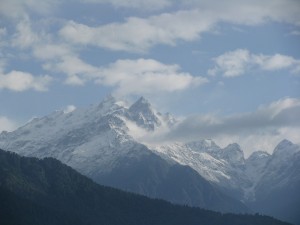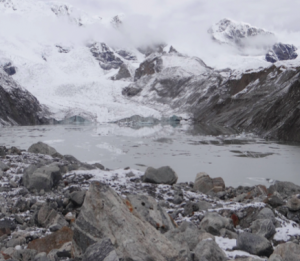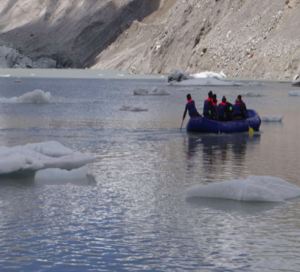31 December 2015
Himalayan glacial lake threatens to flood Buddhist holy city
Posted by Lauren Lipuma
by Amy McDermott
On the road to Kanchenjunga – the second highest peak in the Himalaya and third highest in the world – travelers pass through the Indian village of Chungthang. Above this Buddhist holy city lies an unstable glacial lake: meltwater from South Lhonak Glacier pools on top of the ice, creating a lake with an icy floor that is dammed by a rim of rock.
The lake’s frozen foundation is slowly melting, however, and the rocks that contain it threaten to suddenly, unpredictably collapse. When they fall, a deadly flash flood will roar through the mountains.
Himalayan lakes, like South Lhonak, are becoming more and more common as glaciers retreat due to warming temperatures, according to Anil V. Kulkarni, a glaciologist at the Divecha Center for Climate Change at the Indian Institute of Science in Bangalore. Kulkarni wants to understand how quickly the lakes are growing and how dangerous they are. He studies South Lhonak Lake because it’s large and growing, which suggests that it is unstable, he said.
Although he is unable to predict when the lake will blow out, Kulkarni’s most recent research, presented at the 2015 American Geophysical Union Fall Meeting, predicts that Chungthang will have three to four hours until the town is flooded with water once the floodgates burst.
For South Lhonak Lake, “burst is inevitable, because its core is ice,” Kulkarni said. “When is hard to predict,” he said, but “it could burst anytime.”
To come up with that number, Kulkarni’s team trekked through the Himalaya for 10 days, then paddled out onto the lake and used sonar, in combination with satellite data, to probe its icy basin and measure its volume. They also shot electrical waves into the rock to test for changes in conductivity, which reveal unstable veins of ice beneath the surface. When a vein blows, the lake will drain above it, so the height of the ice determines how much water will escape, according to Kulkarni.
Kulkarni estimates 53 million cubic meters (14 billion gallons) of water fill South Lhonak Lake, spanning an area of 126 hectares (311 acres). Based on long-term satellite data, he thinks it’s grown by over 100 hectares (247 acres) since 1978.
That number will rise as temperatures increase, Kulkarni said. One possible next step is to drain these glacial lakes to spare villages from the deluge, he added.
“Over time, because of climate change, more and more lakes are likely to form in the Himalaya,” Kulkarni explained. “The security of the people living there is threatened.”
‑ Amy McDermott is a graduate student in the Science Communication program at UC Santa Cruz. Follow her on Twitter at @amygmcdermott.













 GeoSpace is a blog on Earth and space science, managed by AGU’s Public Information staff. The blog features posts by AGU writers and guest contributors on all sorts of relevant science topics, but with a focus on new research and geo and space sciences-related stories that are currently in the news.
GeoSpace is a blog on Earth and space science, managed by AGU’s Public Information staff. The blog features posts by AGU writers and guest contributors on all sorts of relevant science topics, but with a focus on new research and geo and space sciences-related stories that are currently in the news.